Introduction
In 2023, the NINDS Office of Pain Policy and Planning (OPPP) conducted an analysis to identify all early-career clinician-scientists who were awarded new NIH career development awards (K awards) to study pain. The analysis focused on grantees who received their awards between 2013 and 2023. The goal was to determine the impact of K awards on their research careers. The Interagency Pain Research Coordinating Committee (IPRCC) noted that there was a need to support early-career clinician-scientists in making the transition to independent researchers to maintain a robust pain research workforce, therefore supporting continual research and innovation. Thus, the analysis focused on awards dedicated to early-career clinician-scientists. Below is a summary of the findings.
Summary of Results and Conclusions
In the past 10 years, NIH has funded 191 K awards for early-career clinician-scientists studying pain. These early-career clinician-scientists were mostly medical specialists or clinical psychologists who had completed their terminal degree 9 years (median) prior and their fellowship training 3 years (median) prior to receiving their K award. Compared to early-career clinician-scientists who applied for, but did not receive, a K award to study pain, early-career clinician-scientists who received a K award had 2.5-fold greater odds of being awarded an R01 or equivalent award. Of the K awardees who received an R01 or equivalent award, half received their R01 or equivalent award within 5 years of beginning their K award. Detailed results are provided below. This data supports the idea that a period of NIH-supported, mentored training increased the chances that an early-career clinician-scientist, who studied pain, would move on to an independent research position.
Results
Number of awards and applications that were not funded based on Institute Center (IC)
Since FY 2013, NIH has funded 191 new K awards for early-career clinician-scientists to study pain. During this time an additional 202 K-award applications were submitted by early-career clinician-scientists, to study pain, and not funded (NOTE: this excludes applications that were not funded initially but were funded after resubmission in a different FY). Most of applications, whether or not they were funded, were submitted to NIDA, NINDS, NIAMS and NCCIH, with the K23 activity code being the most popular.
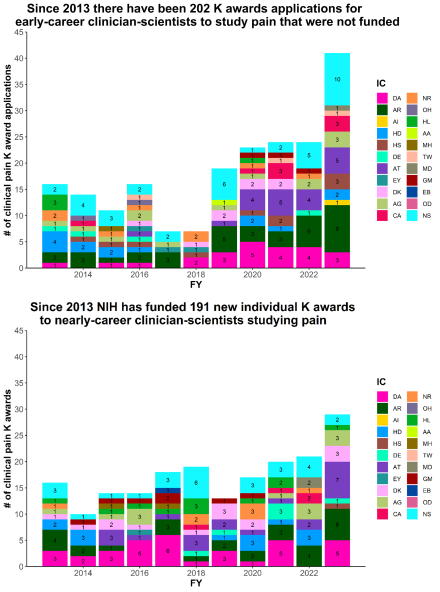
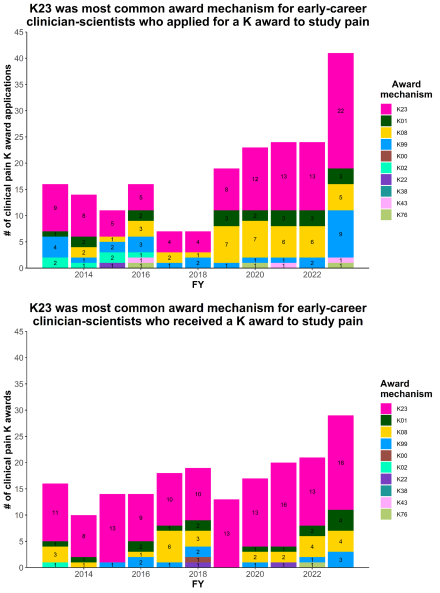
Career stage of K awardees
The IPRCC identified that quality mentorship is an obstacle to success for early-career clinician-scientists. Thus, this analysis examined early-career clinician-scientists who applied for and were awarded mentored K awards (n=134, 15, 26, 11 for K23, K01, K08 and K99, respectively). Most of these early-career clinician-scientists were medical specialists (n=68) or clinical psychologists (n=47). In addition to the 68 medical specialists, there were also 17 pediatric specialists and 13 pain management physicians. Early-career clinician-scientists who were awarded a mentored K award to study pain received their award 3 years (median) after completing their training. Notably, K99 awardees tended to receive their awards before completing their training, which is expected because the K99/R00 activity code is designed to allow a PI to remain a post-doctoral fellow for up to the first 3 years of the grant.
Table 1. Specialties of early-career clinician-scientists who were awarded a mentored K award to study pain from 2013-2023.
|
Specialty |
Number of awardees |
|---|---|
|
Physician Specialist |
68 |
|
Clinical Psychologist |
47 |
|
Pediatric Specialist |
17 |
|
Pain Management Physician |
13 |
|
Nurse |
13 |
|
Physical Therapist |
8 |
|
Primary Care Physician/General Medical Doctor |
6 |
|
Chiropractor |
4 |
|
Dentist |
3 |
|
Pharmacist |
2 |
|
Naturopathic Doctor |
1 |
|
Osteopath |
1 |
|
Dietician |
1 |
|
Athletic Trainer |
1 |
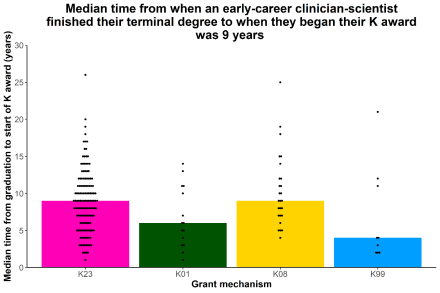
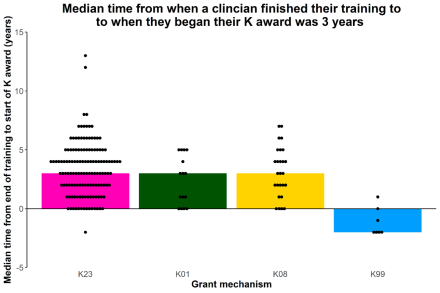
Effect of K award
Of the 191 early-career clinician-scientists who received a K award to study pain (since 2013), 47 (25%) have received an R01 or equivalent award (as of FY 2023). Twenty of the 174 early-career clinician-scientists (11%) who applied for, but did not receive, a K award to study pain (since 2013) were awarded an R01 or equivalent award. It should be noted that the percentages computed above include 113 early-career clinician-scientists who are currently being supported by a K award. When examining only early-career clinician-scientists who completed their K awards, greater than 50% received an R01 or equivalent award, as of FY 2023. Additionally, considering only early-career clinician-scientists who applied for their first R01 or equivalent award, 50% of K awardees and 34% of those who applied for and did not receive a K award to study pain, received an R01 or equivalent award. For context, 50% of K awardees who applied for an R01 or equivalent award receiving an award is higher than the NIH-wide funding rate for first time R01 or equivalent award PIs (22%). Compared to those who applied for, but did not receive a K award, early-career clinician-scientists who received a career development K award to study pain had 2.5 fold greater odds of receiving an R01 or equivalent award (p<0.005). Receiving a K award was not associated with a shorter time to being awarded an R01 or equivalent award, suggesting that the period of mentored career development did not extend time to achieve research independence. However, those who received a K award in 2013 had ~10-fold greater odds of receiving a R01 equivalent award compared compared to those who applied for, but did not receive, a K award that year. The greater likelihood of K awardees receiving an R01 or equivalent award, compared to those who applied but did not receive a K award, is in line with a previous report examining all K award applicants (Nikaj and Lund, 2019).
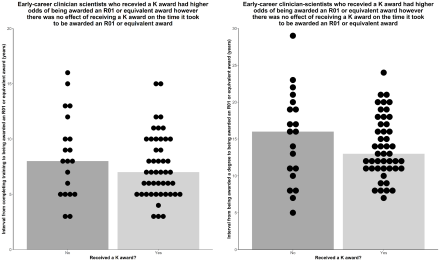
The K award activity code did not appear to impact neither the odds nor the time it took for an early-career clinician-scientist to receive their first R01 or equilvalent award. On average, early-career clinician-scientists received their first R01 or equivalent award within 5 years of being awarded their K award (median). This corresponded to these early-career clinician-scientists being awarded their first R01 or equivalent award within 7 years of completing their training and 13 years of graduating from their terminal degree (median).
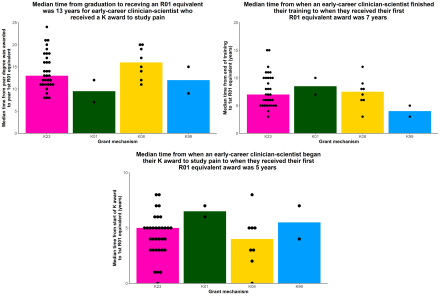
Methods
The analysis used the NIH Querry, View, Report (QVR) system and searched for new K award applications that were submitted to NIH between fiscal years (FYs) 2013 and 2023 and contained the terms “pain”, “analgesia”, “analgesic”, “nociception”, “nociceptor”, “nociceptive”, “headache”, “migraine”, “painful”, “allodynia”, or “palliative” in either the title, the abstract or the specific aims. The analysis filtered out mid-career awards so that our database only included those who applied for K00, K01, K02, K08, K22, K38, K43, K76, K99, or K23 awards. To identify if an application was aimed at studying pain, the titles, abstracts and specific aims of the applications were then manually screened by NIH subject matter experts. After manual screening we were left with 284 K awardees and 544 unfunded K award applications. For this analysis, an early-career clinician-scientist was defined as someone who was qualified to provide medical care to patients (based on their biosketch). If an applicant had either a professional school degree or doctorate that enabled them to apply for licensure to treat patients (e.g. MD, BSN, MBBS, DPT, PSYD, DO, DC, DDS, PHMD, ND, or RN) they were also classified as an early-career clinician-scientists. Biosketches of applicants who received a PhD exclusively were also screened to determine if the applicant had any licensure or training that qualified them to provide medical care for patients (e.g. nurses and clinical psychologists). Applicants’ biosketches were also reviewed to determine when an applicant completed their training. Training was defined as clinical or research experience that was gained between when an applicant completed their terminal degree and when they became full-time faculty at an institution. Examples of training positions were post-doctoral fellowships or medical residencies. To determine whether the activity code was associated with the time it took a K awardee to transition to an independent investigator, a Kruskal-Wallis test was used to analyze the time it took for a PI to successfully compete for an R01 or equivalent award. Additionally, to determine the effect of receiving a K award on achieving independence as a researcher, a Cochran-Mantel-Haenszel test (stratified by time) was used to compare odds ratios of being awarded an R01 or equivalent award between applicants who did or did not receive a K award. Percentages of early-career clinician scientists who received R01 or equivalent awards were calculated for K awardees as well as those who applied for but did not receive a K award. Additionally, percentages of early-career clinician scientists who received R01 or equivalent awards were calculated only for early-career clinician-scientists who applied for an R01 or equivalent award. This latter statistic is similar to the NIH funded rate, but is calculated over a 10-year period instead of a single Fiscal Year (FY), and therefore, is an overestimate of the rate.
